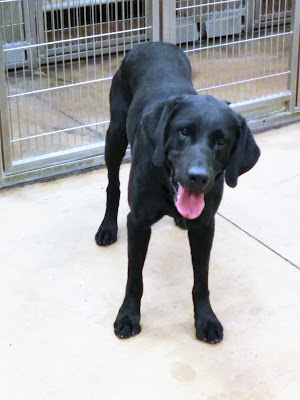Why are black shelter dogs so often overlooked in favor of lighter colored dogs? I think there are two main reasons for this.
🐾 Animal shelters
notoriously have poor lighting. Because
of this, very dark colored dogs are not as visible; they don’t catch your eye as
much and are easy to miss. I’ll admit
there have actually been times when I’ve arrived at the shelter and I’m running
around helping people, and I’ve missed a black dog or two sitting in the back
of their poorly lit kennel. I’ll do a
double- take and think, wow where did that one come from? I simply didn’t see him! I feel
so guilty when that happens.
Poor lighting also makes for a poor photograph, so when people view photos of the shelter’s adoptable dogs online, the photos of black dogs are usually not good and don’t entice people to come see the dog. People now go online when they are looking to adopt a dog or other pet. They no longer run to the shelter first, they scroll through photos of adoptable pets on animal shelter and animal rescue web sites first. If the photo doesn't grab them, they may never go to meet that adoptable dog or other pet.
Poor lighting also makes for a poor photograph, so when people view photos of the shelter’s adoptable dogs online, the photos of black dogs are usually not good and don’t entice people to come see the dog. People now go online when they are looking to adopt a dog or other pet. They no longer run to the shelter first, they scroll through photos of adoptable pets on animal shelter and animal rescue web sites first. If the photo doesn't grab them, they may never go to meet that adoptable dog or other pet.
 |
| Even in sunlight, it's hard to see Dusty's beautiful dark brindle coat |
🐾 Another
thing that contributes to Black Dog Syndrome is that some people think big
black dogs look scary. If they’d only
look closer and give the big guy a chance, they would see a dark, gentle giant with soulful eyes, one that would make a great best friend.
Awhile back, I vowed
to do something to help combat Black Dog Syndrome at the shelter where I
volunteered. As I arrived at the
shelter, I checked every kennel to see if we had black dogs. We always did.
If a smaller black dog was in the bottom row of kennels, I'd move them to
an upper kennel or place them into a larger play area or a meet and greet room
so they can get more visibility.
I moved larger black dogs into a larger area as well to help them stand out more. I'd also put a colorful bandana, sweater, harness,
or collar on them, or place a brightly colored blanket in the kennel to help draw
peoples’ attention as they pass by. “Oh,
look how cute that dog looks in her pink bandana!” A black dog will really pop against orange,
red or pink. Bright multi colored patterns
are even better, they have “movement” and really catch the eye.
 |
| My foster dog, Howdy. |
We once had a beautiful jet black pit bull puppy about 6 months old at
the shelter. He was in the bottom row of
kennels and hardly anyone noticed he was even there. I took him out, tied a colorful bandana on
him, and placed him in a meet and greet room to make him more visible. I also gave him a bright blue squeaky ball to
play with. As people entered the shelter
and passed by the meet and greet room, they could see him clearly…. and hear
him continually squeeking his ball. Let
me tell you, every person that came in noticed this little guy and he was
quickly adopted.
I have since added colorful
squeaky toys to my bag of tricks to help combat Black Dog Syndrome. It’s such a small thing but it makes a huge
difference. If you want to help your local shelter combat potential Black Dog Syndrome, donate some brightly colored
bandanas, dog clothing, collars or harnesses.
I find fabulous collars and harnesses at discount stores. I started buying bunches of them to donate
to the shelter regularly.
 |
| This beautiful large black dog got noticed more when we moved him into a large play kennel and gave him a squeeky ball! A colorful bandana would have helped even more. Yes, he did get adopted! |
Check out photographer Fred Levy's gorgeous photos of black dogs, which he creatively photographed against a black backdrop in his Black Dogs Project at, www.fredlevyart.com

2 comments:
Ooo I never thought about that given that Ruckus is a white fluffy dog. Im sure if an eskimo was all matted and desheveled then it would still be a problem.
Yes, if a dog is really matted it can be a total turnoff at the shelter, not everyone has the vision to see a dog's potential beauty both outside and within. If they come in looking like a hot mess, we try to groom them or get a groomer to donate their time. Thanks for your comments, it's nice to connect with you!
Post a Comment